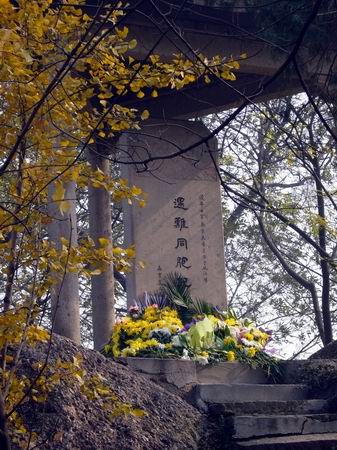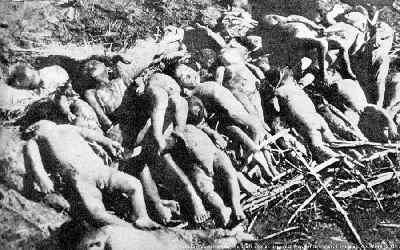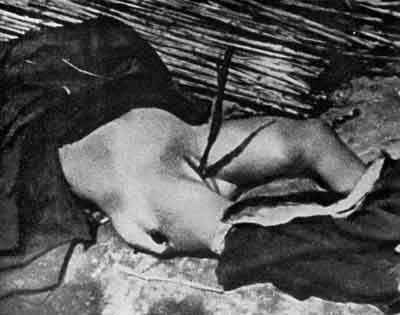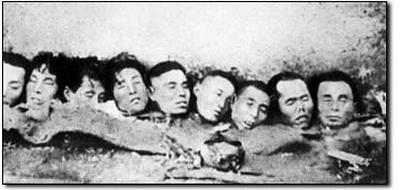






Atrocities begin
Chinese civilians to be buried alive.[22]
Eyewitness accounts from the period state that over the course of six weeks following the fall of Nanjing, Japanese troops engaged in rape, murder, theft, and arson. The most reliable accounts came from foreigners who opted to stay behind in order to protect Chinese civilians from certain harm, including the diaries of John Rabe and Minnie Vautrin. Others include first-person testimonies of the Nanjing Massacre survivors. Still more were gathered from eyewitness reports of journalists, both Western and Japanese, as well as the field diaries of certain military personnel. An American missionary, John Magee, stayed behind to provide a 16mm film documentary and first-hand photographs of the Nanjing Massacre. This film is called the Magee Film. It is often quoted as an important evidence of the Nanjing Massacre. In addition, although few Japanese veterans have admitted to having participated in atrocities in Nanjing, some—most notably Shiro Azuma—have admitted to criminal behavior.
Immediately after the city’s fall, a group of foreign expatriates headed by John Rabe formed the 15-man International Committee on November 22 and drew up the Nanking Safety Zone in order to safeguard the lives of civilians in the city, where the population ran from 200,000 to 250,000. It is likely that the civilian death toll would have been higher had this safe haven not been created. Rabe and American missionary Lewis S. C. Smythe, the secretary of the International Committee, who was also a professor of sociology at the University of Nanking, recorded atrocities of the Japanese troops and filed reports of complaints to the Japanese embassy.
[edit]Rape
It is a horrible story to relate; I know not where to begin nor to end. Never have I heard or read of such brutality. Rape: We estimate at least 1,000 cases a night and many by day. In case of resistance or anything that seems like disapproval there is a bayonet stab or a bullet.
—James McCallum, letter to his family, 19 December 1937
There probably is no crime that has not been committed in this city today. Thirty girls were taken from the language school last night, and today I have heard scores of heartbreaking stories of girls who were taken from their homes last night—one of the girls was but 12 years old… Tonight a truck passed in which there were eight or ten girls, and as it passed they called out “Jiu ming! Jiu ming!”—save our lives.
—Minnie Vautrin’s diary, 16 December 1937
The International Military Tribunal for the Far East stated that 20,000 women were raped, including infants and the elderly.[23] Rapes were often performed in public during the day, sometimes in front of spouses or family members that were tied up and forced to watch. A large number of them were systematized in a process where soldiers would search door-to-door for young girls, with many women taken captive and gang raped.[24] The women were often then killed immediately after the rape, often through mutilation, including breasts being cut off;[25] or stabbing by bamboo (usually very long sticks)[26], bayonet, butcher’s knife[citation needed] and other objects into the vagina. According to some claims, other women were forced into military prostitution as comfort women. There are also claims of Japanese troops forcing families to commit acts of incest.[27] It has been claimed that sons were forced to rape their mothers, fathers were forced to rape daughters. One pregnant woman who it is claimed was gang-raped by Japanese soldiers gave birth only a few hours later; the baby was perfectly healthy (Robert B. Edgerton, Warriors of the Rising Sun). Monks who had declared a life of celibacy were according to some claims forced to rape women for the amusement of the Japanese.[27]
[edit]Murder
Massacred Chinese civilians at ditch in Xuzhou[28]
Various foreign residents in Nanking at the time recorded their experiences with what was going on in the city:
Robert Wilson in his letter to his family: The slaughter of civilians is appalling. I could go on for pages telling of cases of rape and brutality almost beyond belief. Two bayoneted corpses are the only survivors of seven street cleaners who were sitting in their headquarters when Japanese soldiers came in without warning or reason and killed five of their number and wounded the two that found their way to the hospital.[29]
John Magee in his letter to his wife: They not only killed every prisoner they could find but also a vast number of ordinary citizens of all ages… Just the day before yesterday we saw a poor wretch killed very near the house where we are living.[30]
Robert Wilson in another letter to his family: They [Japanese soldiers] bayoneted one little boy, killing him, and I spent an hour and a half this morning patching up another little boy of eight who had five bayonet wounds including one that penetrated his stomach, a portion of omentum was outside the abdomen.[31]
Immediately after the fall of the city, Japanese troops embarked on a determined search for former soldiers, in which thousands of young men were captured. Many were taken to the Yangtze River, where they were machine-gunned so their bodies would be carried down to Shanghai. The Japanese troops gathered 1,300 Chinese soldiers and civilians at Taiping Gate and killed them. The victims were blown up with landmines, then doused with petrol before being set on fire. Those that were left alive afterwards were killed with bayonets.[32] Some people were beaten to death. The Japanese also summarily executed many pedestrians on the streets, usually under the pretext that they might be soldiers disguised in civilian clothing.
Thousands were led away and mass-executed in an excavation known as the “Ten-Thousand-Corpse Ditch”, a trench measuring about 300m long and 5m wide. Since records were not kept, estimates regarding the number of victims buried in the ditch range from 4,000 to 20,000. However, most scholars and historians consider the number to be more than 12,000 victims.[33]
Women and children were not spared from the horrors of the massacres. Often, Japanese soldiers cut off the breasts, impaled them with bayonets until the blade protruded out of the back, disemboweled them, or in the case of pregnant women, cut open the uterus, removed the fetus. Witnesses recall Japanese soldiers throwing babies into the air and catching them with their bayonets. Pregnant women were often the target of murder, as they would often be bayoneted in the belly, sometimes after rape.[34] Many women were first brutally raped then killed. The actual scene of this massacre is introduced in detail in the documentary film of the movie “The Battle of China”.
The Konoe government was well aware of the atrocities. On 17 January, Foreign minister Koki Hirota received a telegram written by Manchester Guardian correspondent H.J. Timperley intercepted by the occupation government in Shanghai. In this telegram, Timperley wrote:
Since return [to] Shanghai [a] few days ago I investigated reported atrocities committed by Japanese Army in Nanking and elsewhere. Verbal accounts [of] reliable eye-witnesses and letters from individuals whose credibility [is] beyond question afford convincing proof [that] Japanese Army behaved and [is] continuing [to] behave in [a] fashion reminiscent [of] Attila [and] his Huns. [Not] less than three hundred thousand Chinese civilians slaughtered, many cases [in] cold blood.[citation needed]
is this from wikipedia
yeah.
Edit: not anymore it isn’t - forum policy on Wikipedia is and has been for some time that wholesale copy and paste from it serves no purpose and does not add to the site. Accordingly I have removed the material you pasted in and provided a link to the original article. Do not do this again - pdf27
If anything, I don’t think the Rape of Nanking is forgotten if they still teach it in history classes.
By the way, was it really necessary to post some of those pictures?
Bud i know but it needs to be put up to showthat the Japanese were as brutal as the NAZIS.
The Japanese were very brutal if you happened to be chinese, just like the Nazis were brutal if you were Jew or Russian.
The Japanese had been learning from the Chinese since Tang dynasty and the last thing they ever learn is to treat fellow beings with respect.
After defeating the Russian Far East fleet in WWI and gained much of Chinese territories prior to WWII, they think they can be master of whole Asia and yet they considered themselves as non- Asian.
Well that was all past now,but we need to see the photos as to remind that what can happen if the weak cannot unite and protect themselves.
Probably, as long as some ruling Japanese try to prevent publication of photos and films of Japan’s depredations in Nanking, and elsewhere. The pictures should be pasted on every lamp post in every country which mistakenly thinks that Japan is run by people who, like the rest of the world, abhor what Japan did during WWII.
Film on Japan’s ‘sword spirit’ revives war debate
Apr 1, 2008
Beijing - An award-winning documentary on Japan’s controversial Yasukuni shrine faced an uncertain future on Tuesday amid threats against the makers and cancellations by worried cinema operators.
‘The reaction in Japanese society is more and more intense,’ the Chinese director, Li Ying, told Deutsche Presse-Agentur dpa in Beijing.
Li’s film Yasukuni explores the historical and social significance of the Shinto shrine for Japan and its East Asian neighbours.
‘This is not a politically confrontational film,’ Li said. ‘It is a cultural dialogue.’
'I ask a big question. The meaning is in how Japanese society responds, but now they say I have the problem.
‘If Japanese society is really like that, it’s very dangerous… it’s a tragedy,’ he said.
At a special showing for lawmakers last month, following a request by conservatives in the ruling Liberal Democratic Party, some asked if the film was ‘anti-Japanese’ and questioned its funding by the Japan Arts Council.
‘No other Japanese film has received pressure like this,’ Li said.
Li, 44, is a permanent resident of Japan. ‘I’ve already lived in Japan for 19 years, I’ve run my film company for 15 years,’ he said.
Many Japanese producers, editors and technicians also worked on the film, ‘so why can’t my film count as a Japanese film,’ he said.
The two-hour documentary includes a long section on petitioners from Taiwan, South Korea and Japan’s Okinawa island who are trying to remove the names of their relatives from the list of people enshrined at Yasukuni.
The shrine was built in 1869 under Emperor Meiji and today it commemorates the 2.5 million Japanese who have died in wars since 1853, including 14 soldiers convicted as class-A war criminals after World War II.
The focus of Li’s film is 90-year-old Kariya Naoji, who for decades crafted the weapons that many believe embody the spirit of those who are honoured at Yasukuni.
About 8,100 swords were forged at Yasukuni from 1933 to 1945, according to the film.
Kariya saw the documentary and was satisfied with it but the ailing swordsmith has also received threats, Li said.
Li began making the film in 1997 after hearing right-wing historians speak at a seminar to mark the 60th anniversary of the Nanjing massacre.
Police at Yasukuni regularly inspected his identity card but did not interfere in his filming, though conservatives seized his film several times over the 10 years it took him to complete the work.
The 123-minute Yasukuni won a best-documentary award in late March at the 32nd Hong Kong film festival, where it had a ‘very enthusiastic’ reception.
It was also shown at international film festivals in South Korea, Germany and the United States, but Culture Minister Kisaburo Tokai on Tuesday said he regretted the cancellation of screenings by five cinemas in Japan.
The Association of Japanese Directors, to which Li belongs, has also supported his right to freedom of expression.
Li said greater artistic freedom was one of his motivations for living in Japan, after previously making Chinese state television films that were ‘not entirely according to my wishes.’
The most controversial scenes in his new film link the Yasukuni swords to the 1937-38 Nanjing massacre, which some Japanese rightists continue to deny, and to a wartime competition between two Japanese officers to be the first to behead 100 people with their swords.
During the showing on March 12 to Japanese lawmakers, who were ‘mainly opposed’ to the film, some of them asked Li to remove the photographs of the Nanjing massacre.
Li sees ‘long-term contradictions in Japanese society’ behind the debate over Japan’s wartime history.
‘It’s a tragedy that they want to cut off the ability to reflect,’ he said.
At one press conference in Japan last month, Li said he asked journalists, ‘Why haven’t the Japanese media investigated this issue?’ The subsequent reports failed even to mention his question, he said.
He said he travelled back to China from the Hong Kong film festival mainly to be with his father, who is seriously ill in hospital, and planned to return to Tokyo later this week.
He admitted some trepidation about facing the threats of ‘political violence’ from rightists, while managers of the Tokyo building housing his film company have already asked him to move out.
But Li said he could not stay in China while Chinese and Japanese and colleagues involved in the film bore the brunt of the intimidation.
‘We don’t know if they (rightists) are going to do something extreme,’ he said. ‘The other people are all there, so I can only stand with them.’
http://www.monstersandcritics.com/movies/features/article_1397895.php/Film_on_Japans_sword_spirit_revives_war_debate
To balance my last post, it should be noted that the nationalist / fascist elements which continue Japan’s wartime mentality in modern form are not representative of the whole of Japanese society or thinking http://www.japanfocus.org/_Li_Ying__Sai_Yoichi-Yasukuni__The_Stage_for_Memory_and_Oblivion/
Alas, they just happen to be be very influential at senior levels of government.
It might also be noted that the Chinese were pretty handy with the sword against their own people. It’s not like the Japanese invented beheading. http://beheadings.spaces.live.com/blog/
Rape of Nanking isint in any of the japanese school books.
As far as i know Japans don’t deny the Nankin massacre at all. They just doubt in figues 200 000 of victims that traditionally is claims by the Chineses.
The 20 000 is “confirmed” , Japanes think.
I don’t know how much it’s true, but we know fro sure- not eveything the Commi speak is absolute true:)
Even China’s commi.
We know as Goebbels persisted about 250 000 killed in Dresden, but only 25 000 are confirmed.
But not Japanes did a worst things during the wars in 20 centure, mate.
And of course in many of countries today the some peoples isn’t even going to admit thier former chiefs commited the crimes.
Look for instance at Baltic states where the Waffen -SS veterans( who helped Nazic very well in baltic Holocaust) go on parades.
And…
Do you really think that Chineses are much better the Japs?
Did you see how they executed their own woman?
http://www.peacehall.com/news/gb/china/2004/12/200412130343.shtml
If they do it now, what did they during ww2?
The Chinese estimates are based on the observations of Westerners in the city at the time. And in fact, many have criticized the Chinese gov’t for themselves largely muting the massacre…
The same could be said of Japan’s colonies and conquered territories, notably Korea which provided some of the biggest mongrels on Japan’s side.
It’s nice for those countries to be able to blame Japan and Germany for what some people from conquered or allied nations did voluntarily, and enjoyed.
I strongly doubt that the Western observers even have the possibility to count the figures of victims in occuped China.Firstly they simply has no reliable way to get a statistic.
Or how do you think they were going to estimate that big massacre?
And in fact, many have criticized the Chinese gov’t for themselves largely muting the massacre…
Well many in West also criticize the Official datas about victims of firebombing/a-bombing( especialy revisionists) but hardly we can get thier point s absolute true.
You have to realize - in any country there are a number of nationalists/extremists who always have a tend to overestimate the Violence of their enemies during the war.
I/m not going to say that the somebody here are extremists:)
But the anti-japane feeling still strong among the anglo-saxons and especialy among Australians who suffered a lot from Japanes.
SO this is not easy to be objective in this theme fro some of them.
Hi abi.
Welcome on the board.
That’s from we can conclude that Indonesians were quite unhappy under Dutch rule.So they initialy thought the Jap has come to liberate them.
But why so many Indonesians have joined to PETA?Really they hoped to win the “evil White Colonizers” under japane leadership?
At the time, it was probably more a case of the event being exploited by the West for propaganda purposes. The Chinese didn’t have much in the way of news outlets in the West that would get the event into newspapers and movie theatres.
The only anti-Japanese feeling here, apart from some of the few remaining survivors of the war and their immediate families, is directed towards Japanese denials of their conduct and the ever-present fascist / nationalist elements in Japanese government that threaten to turn back the clock.
Apart from that, we get on quite well with the Japanese people, most of whom don’t share the dangerous views of a small proportion of their politicians and commercial / industrial leaders.
Possibly.
Those of us who know what vicious, brutal, merciless bastards the Japanese were during the war don’t have any trouble believing that they carried out the Rape of Nanking, where after all they were just, literally, blooding some of their soldiers.
That doesn’t mean we accept the figures, but I don’t know that figures mean that much once it’s established that a mass atrocity has occurred.
For example, I don’t really care whether six or four or two million Jews were exterminated by the Nazis, with the willing assistance of some other Europeans who were just as anti-Semitic. Whatever happened, it was an appalling exercise beyond all comprehension and the culpability of those responsible for it isn’t made less bad by reducing the number from six million, nor worse by increasing it. Same with Nanking.
Many influential Japanese in intellectual, academic, journalistic and commercial circles debated and genuinely believed in the couple of decades before the war that Japan had a mission to liberate Asia from European colonialism.
Which, oddly enough, is the only enduring beneficial consequence of Japan’s war, and about the only good to come out of it. Apart from Japan’s economic miracle. :rolleyes:
Japan convinced independence leaders and movements in many countries that it was their saviour and that it would give them independence.
Japan just forgot to tell them that the Greater East Asia Co-Prosperity Sphere was based on the notion of Asian nations’ independence, upon Japan’s terms and for Japan’s benefit.
The Dutch and other colonial powers weren’t great colonial masters by today’s standards, and perhaps not by the standards of the time as observed in the home countries of the colonial powers, but they were pretty much a benevolent regime compared with the Japanese. It just took a long time for some people in occupied territory to work that out after they’d thrown in their lot with the Japanese after believing that Japan would give them independence.
I don’t know how much it’s true, but we know fro sure- not everything the Commi speak is absolute true
Even China’s commi.
Maybe you were just being sloppy in your language, but this bothered me. I thought at the time Nanking was still under Nationalist control? I admit my knowledge of the Pacific war is much shakier than of the European war (which isn’t always so hot either), but I thought the areas under communist control at that time were both rural and negligible, and didn’t include any large (if any!) cities. But if it was “communist” that may provide an ideological motivatation of which I was previously unaware of for what happened.
I can explain.
Firstly i seriously doubt that Pacific war was more shakier then the Eastern European one.
The Asian cruelty can’t always compete with Nazic inventions of mass killing.
Indeed at the time Nanking was ALREADY under Japane control, so Nationalists can do nothing.
Soon after he war the Gomindan have been beaten by Communists so hardly they have enough time to calculate all the figures of Japane terror.
The figures of 200 000 killed today shares the Communists powers ( That indeed are pretty Chinas Nationalists too)
How they count their dead i can explane you in one interesting military conflict.
We had a few serious border conflict in 1969
http://en.wikipedia.org/wiki/Sino-Soviet_border_conflict
In march battels soviets lost 58 soldiers and officers killed( the name all of them are known)
The Chinas estimets were 150…3000 dead.
Learn the diffrence.I mean how they “calculate” their casualties.
The official Chinas propogand spread something about " few casualties" that of course in nonsense coz Soviet Army had used the Jet Mortars BM-21 “Grad” widely in this conflict.
So i can’t get the CHinas figures as absolut truth any more.